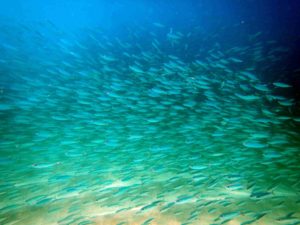
Waimea Bay halalu. ©Craig Thomas
September 25, 2020
Although I am neither a parent nor a teacher, I’m still passionate about schools—of fish, that is.
I’ve had great appreciation for schooling fish since a snorkeling adventure off an island in Tonga in 2006, when a million or so individuals of an unknown fish species allowed me to enter their enormous ball of bodies. Rather than scattering, the 4-inch-long fish incorporated me into their school, each keeping a precise distance from me and each other, creating a work of sparkling kinetic art.
Since then, when I see a school of fish, I try to swim among them, but viewing me as a predator, they’ll have none of it. The entire school either moves off as a tight group, or individuals abandon formation and flee. But that’s OK, I appreciate those mobile masterpieces too.
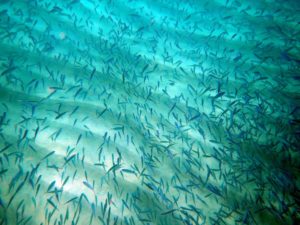
Fish manage to keep an exact distance from one another by means of tiny organs embedded in their skin, giving them a sense of “distant touch.” Some of these microscopic organs are on the head and body surface, and some are embedded at the bottom of shallow skin pits. Other distance-touch cells are concentrated in canals, called lateral lines, that run lengthwise down each of the fish’s sides. We can see lateral line in some species, others not.
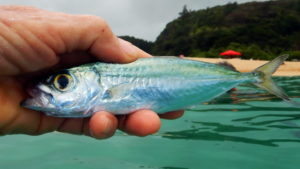
The lateral line is visible on the rear of this halalu, found floating, uninjured, above its school. ©Susan Scott
An individual distant-touch cell consists of an upright pole, or mast, filled with a jellylike substance. Nerve-connected hairs sit at the mast’s base. When water moves, the flexible mast bends, in turn bending the base hairs that stimulate nerves. The direction of the bend informs the fish what’s happening, and it reacts accordingly.
These distant-touch cells in a fish’s head, body, and lateral line continually send messages to the brain, even when the water is undisturbed. This keeps fish from running into coral heads, piers, and other stationary objects.
Distant-touch systems have evolved differently to suit various life styles. (Human hearing works on a similar pressure-wave system, only in air rather than water.) Sedentary fish have extensive distant-touch cells on their skin’s surface, but in constant-swimming species, the distant-touch cells lie deeper. This enables fast-swimming fish, and fish in streams, to separate continuous rushing water from disturbance in the water, handy for finding prey, as well as not becoming prey.
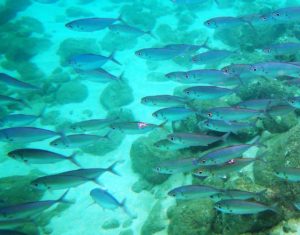
One theory of schooling its that there is safety in numbers. Even so, a couple of these ‘opelu (center and lower right) received wounds from predator strikes. ©Craig Thomas
Some Hawaii fish, such as flagtails, or aholehole, rest in tight schools on reefs and in caves during the day, spreading out at night to eat drifting animal plankton.
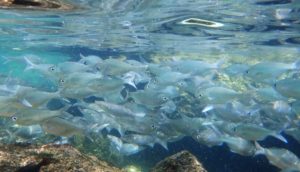
A couple of mullet (center left) are sheltering among this school of aholeahole in a cave at Shark’s Cove. ©Susan Scott
March and April are peak months for adult yellowstripe goatfish, weke’a, to spawn, releasing sperm and eggs into the water. By July or August, the offspring, called ‘oama when less than 7 inches long, hang together in large schools that anglers catch for food and bait.
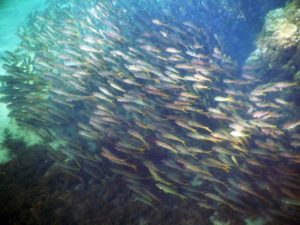
Schooling ‘oama, Waialua. ©Susan Scott
Mackerel scad, called ‘opelu, sometimes school up in what anglers call bait balls, convenient snack bars for tunas, jacks and other predatory fish. A related species called bigeye scad, or akule, (the young are called halalu) also form schools, their masses looking like drifting dark clouds in our turquoise bays.
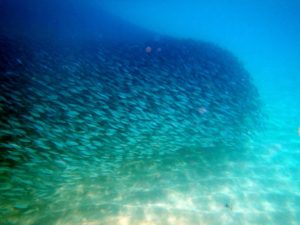
Beauty in a ball of fish. Waimea Bay, 2020. ©Craig Thomas
During that sunny morning in Tonga, I took advantage of the fish’s social distancing instincts to make aquatic “snow angels,” the fish so numerous and so densely packed that a few times I dove down and floated up, I couldn’t tell up from down. I don’t know what those Tonga fish were thinking in allowing me into their fold, but it’s why I love getting in the ocean. For reasons known only to the animals, they sometimes give me an inside view of their amazing lives.